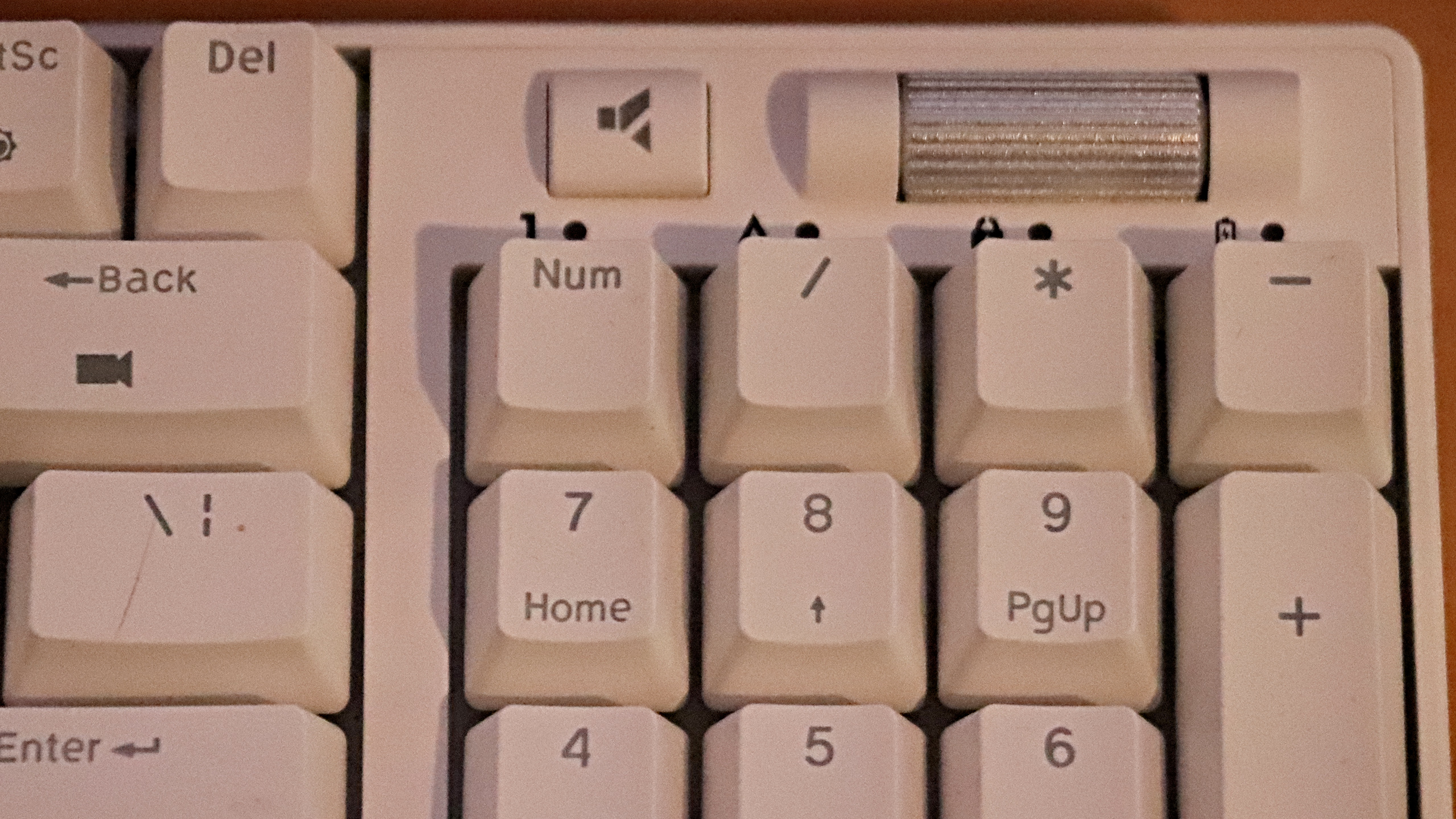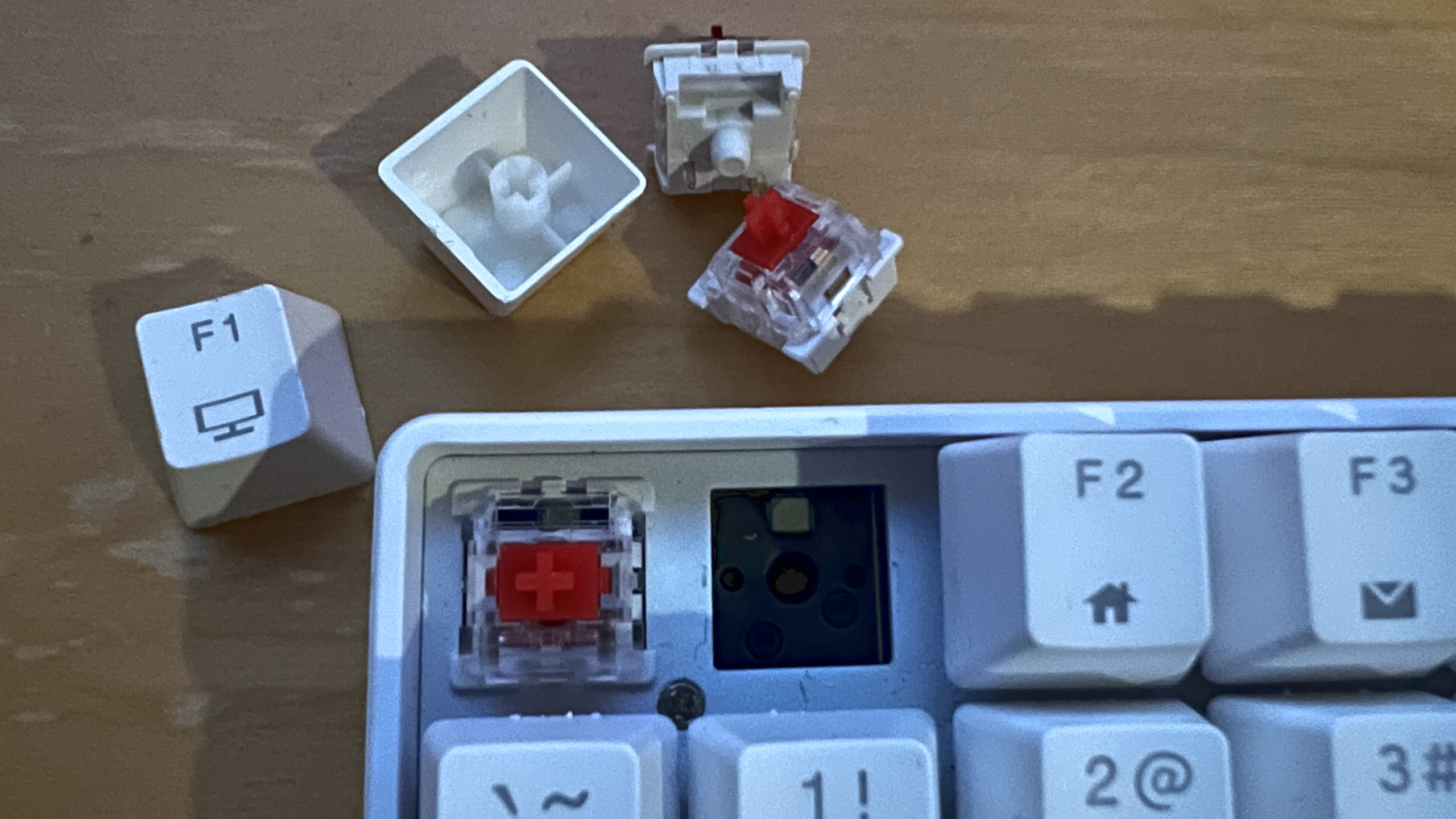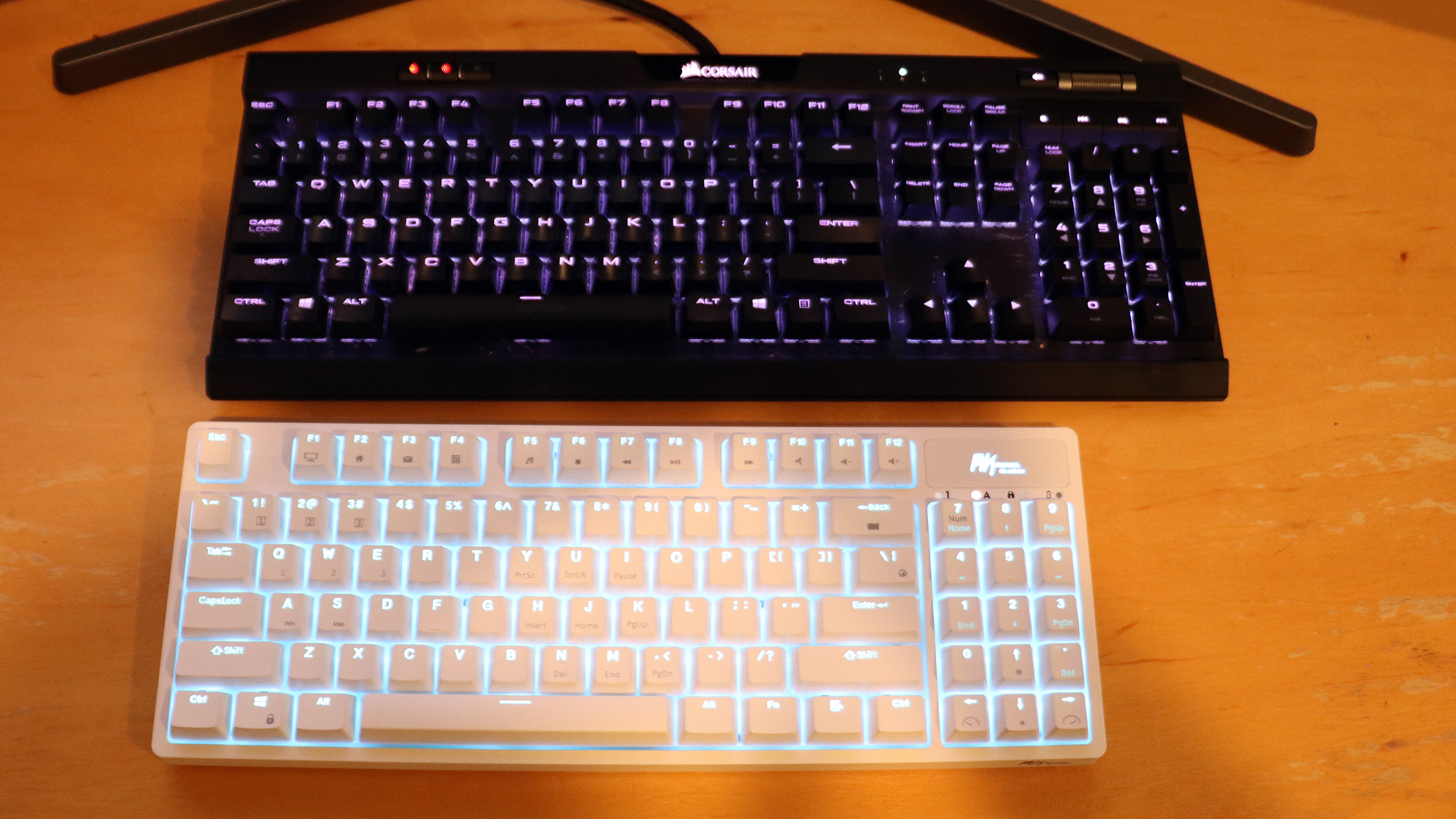Tom's Hardware Verdict
The Royal Kludge RK96 is a solid, flexible and inexpensive entry into keyboard customization that also works well with a wide variety of devices right out of the box.
Pros
- +
Inexpensive
- +
Sturdy build
- +
Compact but has a full keypad
- +
Excellent volume control design
- +
Hot-swappable switches
- +
USB 2.0 passthrough
- +
Three Bluetooth profiles
Cons
- -
Unpolished software
- -
Missing page navigation keys
- -
USB ports completely disabled in wireless mode
Why you can trust Tom's Hardware
The brand name "Royal Kludge" might not instill a high level of confidence, but the Royal Kludge RK96 is a pleasant surprise with its comfortable design, flexible connectivity, and impressive configurability.
This 96-key keyboard shaves a full three inches off the width of a standard 104-key design by omitting a few navigation keys and tightening up a few others, but is still very comfortable for touch-typing. Its RK switches don’t have the name-brand cred of Cherry MX switches, but they feel good and are hot-swappable.
The RK96 offers several connection options, including USB, Bluetooth and an included 2.4 GHz dongle (which exhibited none of the issues we saw with the RK84’s dongle). The keyboard has a sizable internal battery for wireless use, and a pair of passthrough USB 2.0 ports that can be used in wired mode. The only real disappointment with this keyboard was its unpolished software. The RK96 retails for $80, which makes it a solid contender for our best budget mechanical keyboards list.
Royal Kludge RK96 Specs
| Switches | MX-compatible Red, hot-swappable |
| Lighting | Ice blue LED backlighting |
| Onboard Storage | Single profile |
| Media Keys | Volume roller, mute, and secondary FN keys |
| Interface | USB-C Wired, Bluetooth, 2.4GHz dongle |
| Cable | 70-inch USB-A to USB-C cable |
| Additional Ports | 2x USB 2.0 passthrough |
| Keycaps | Doubleshot ABS passthrough |
| Construction | Plastic |
| Software | Royal Kludge software |
| Dimensions (LxWxH) | 14.75 x 4.6 x 1 inches |
Design
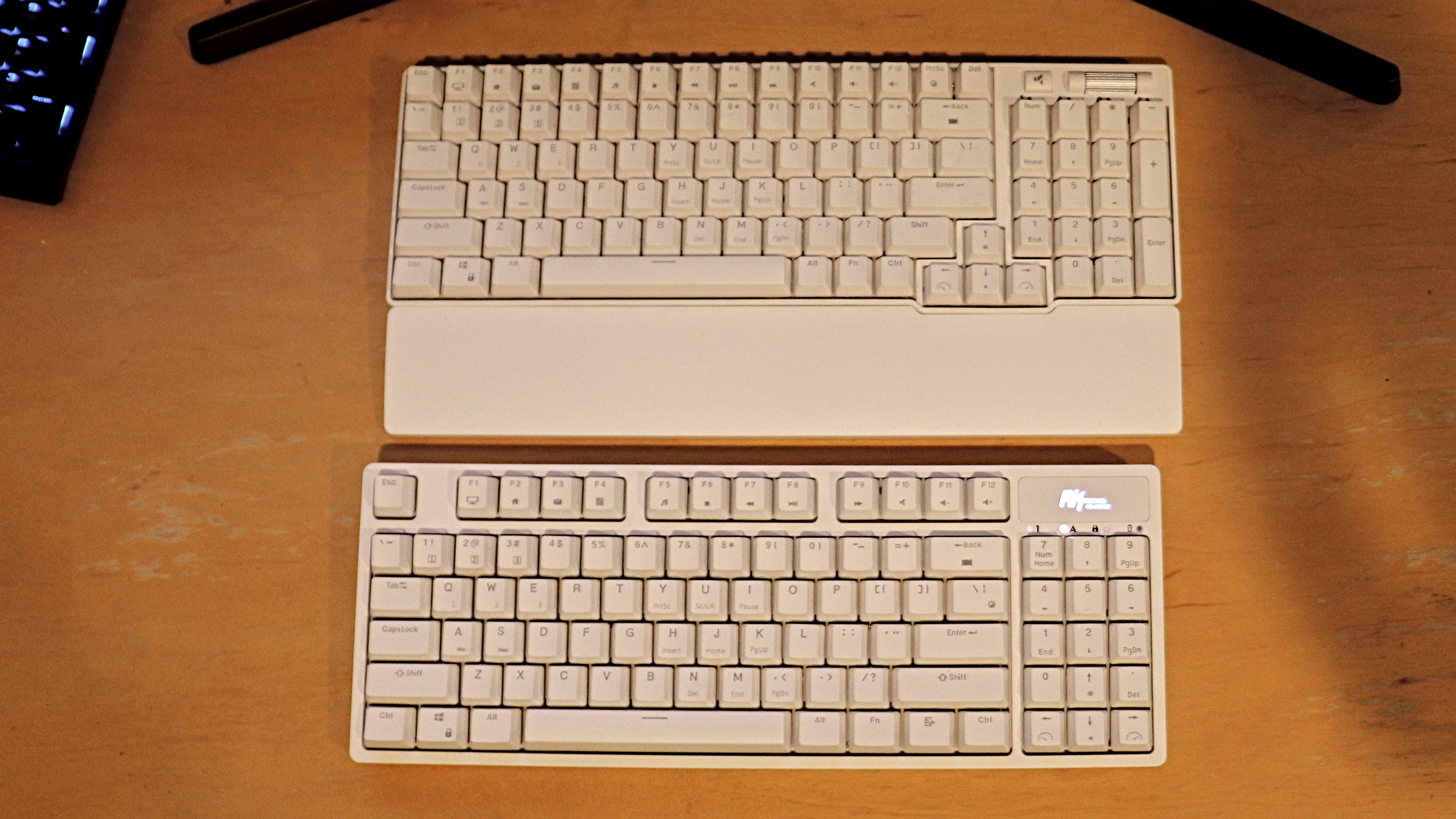
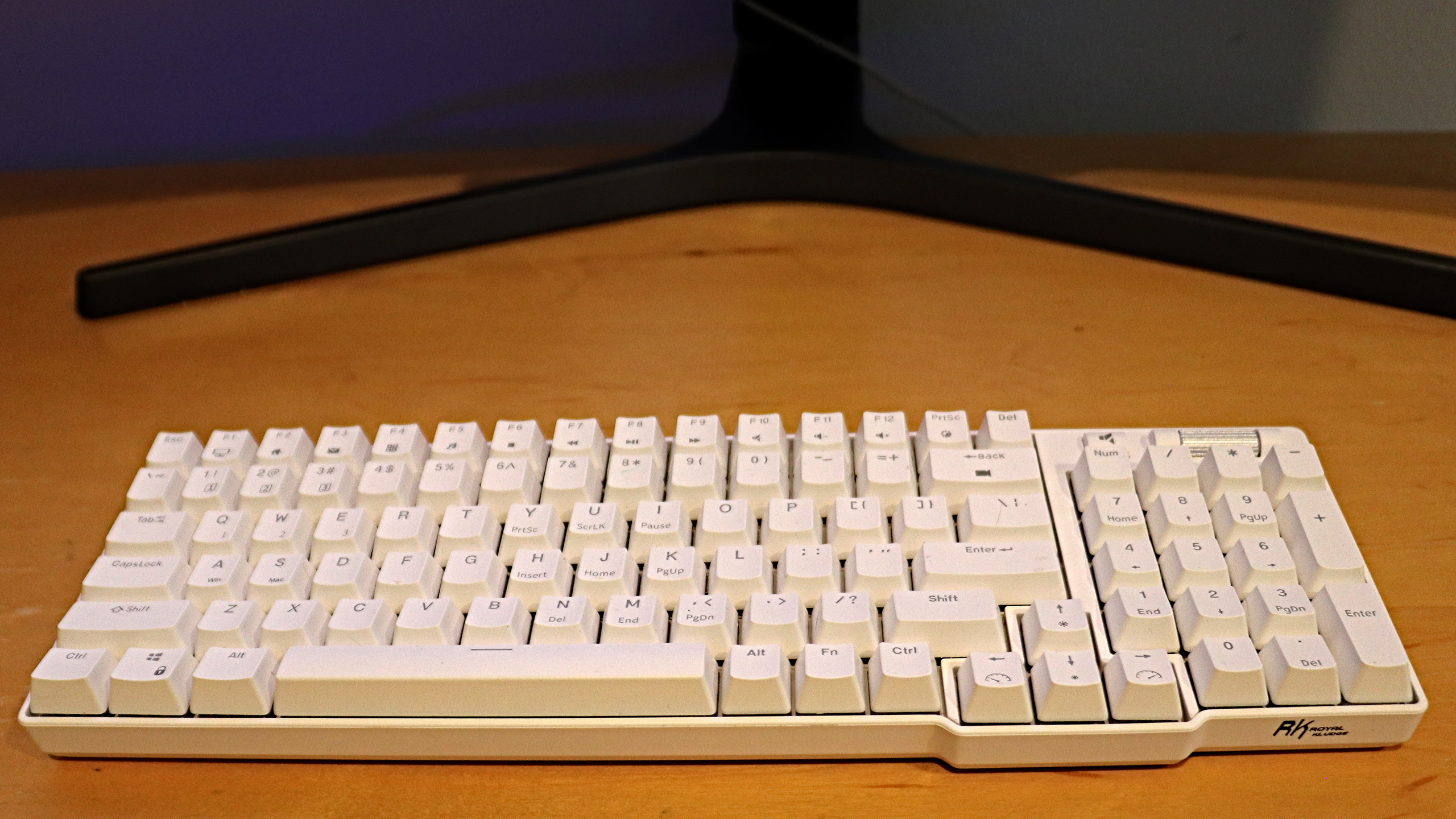
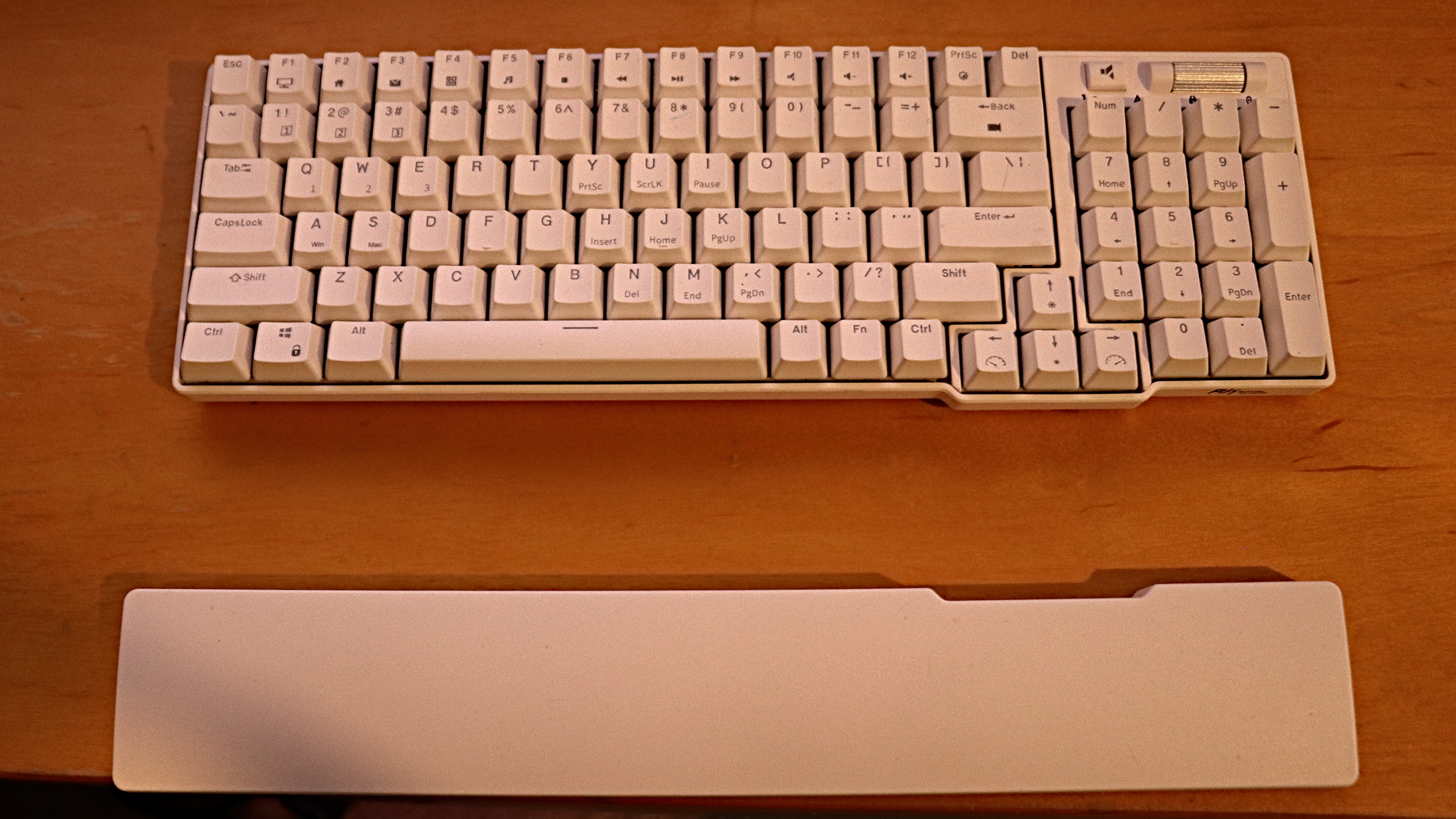
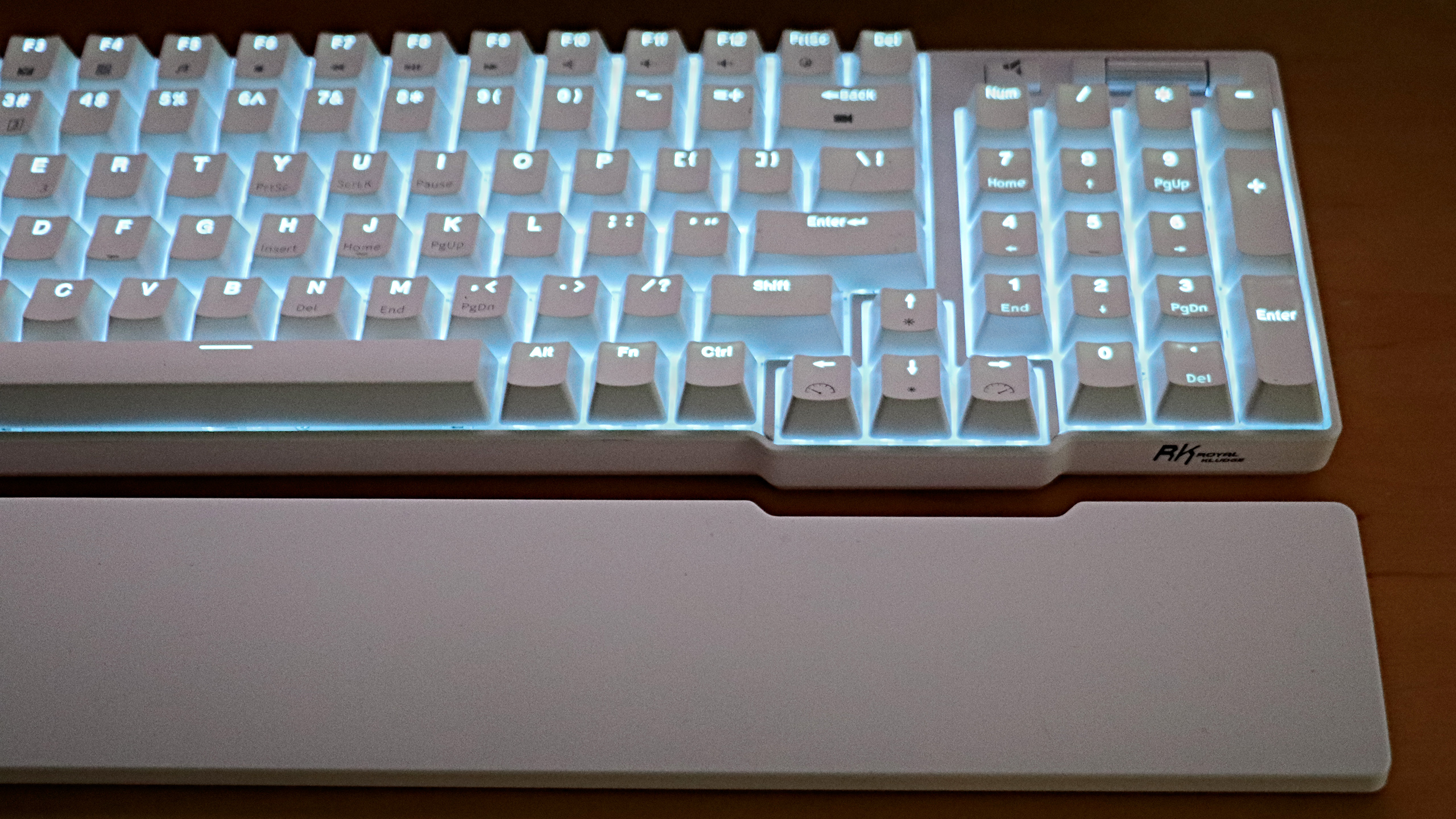
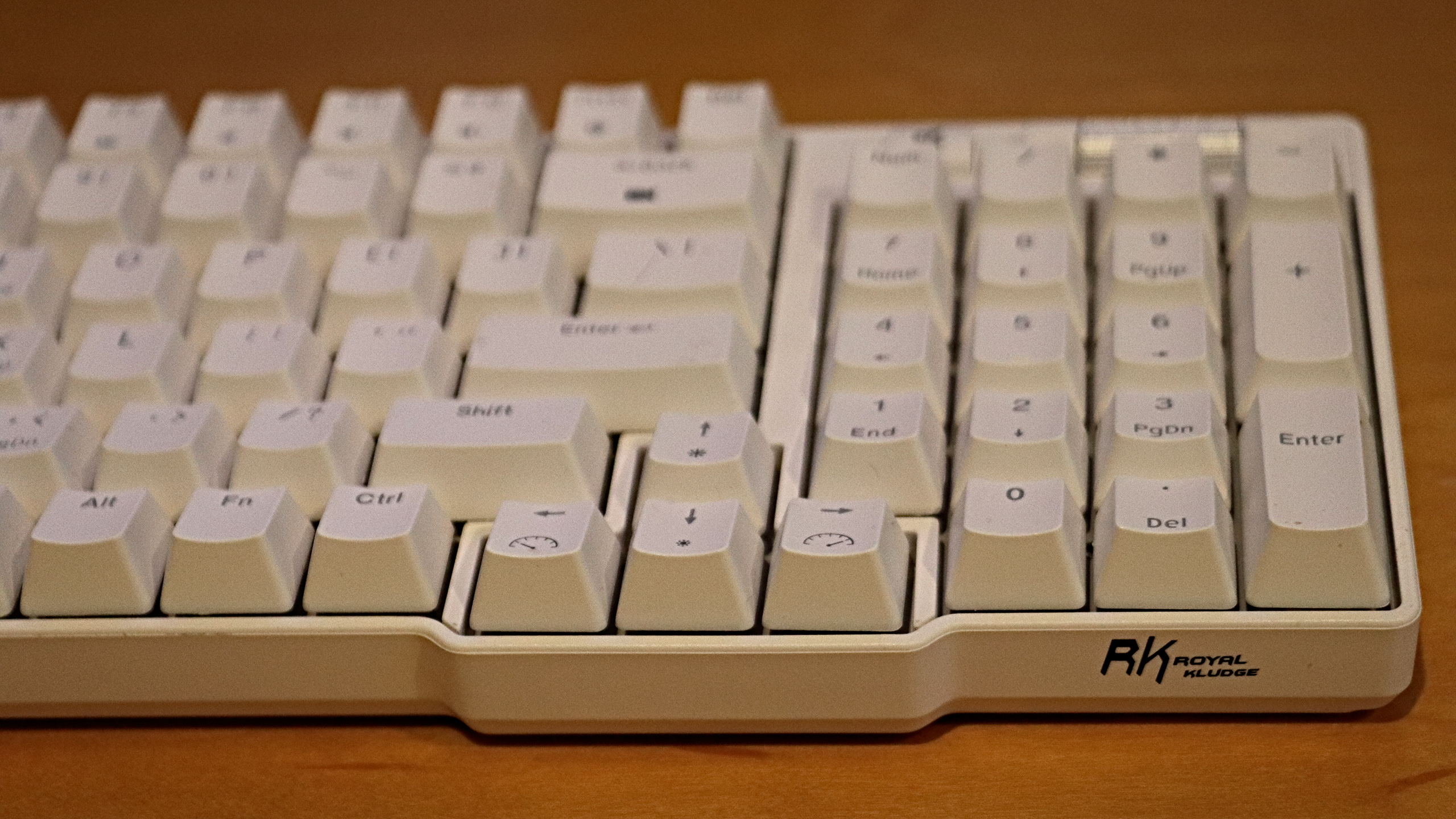
The RK96 features a white design and soft blue lighting. The keys resisted dirt and discoloration over the course of my testing, despite the board’s light color scheme. The RK96 has a full numeric keypad, but is about three inches smaller than a typical 104-key keyboard — it achieves this by omitting the navigation keys typically found above the cursor keys, removing most of the space between the alphanumeric keys and the keypad, and shrinking the keypad's 0 key. The RK96 measures 14.75 inches wide, 4.6 inches deep, and is one inch tall (not including the board’s flip-out feet).
The end result is a keyboard that still feels as comfortable as a 104-key keyboard but saves space on smaller desks. The F1-F12 keys are pushed together to make room for PrtSc and Del keys above the Backspace key, and the board omits dedicated Insert, Home, End, Page Up, and Page Down keys. You can still access those keys’ functions using the numeric keypad, or — if you’re using that for number entry — via the Fn key in conjunction with labeled letters on the main keyboard. I found it fairly easy to adjust to the missing keys, though I did have to retrain myself to use Fn-I in place of the dedicated Pause key to freeze Microsoft Flight Simulator. The cursor arrows are closer to the other keys than they are on a standard 104-key keyboard, they’re still in the expected place and shouldn’t cause issues for touch-typists.
Above the keypad you’ll find a volume roller and mute button in a configuration nearly identical to the roller on my more expensive Corsair K95. The roller works well, though it’s much closer to the keypad than the roller on the Corsair — if you’re not careful you may end up pressing the asterisk key while reaching for it. The other media control keys found on volume-roller-equipped Corsair keyboards aren’t present here, which isn’t surprising given the compact size. Instead, the function keys double as media control keys in conjunction with the Fn key.
In the box you’ll find the 2.4 GHz receiver (which stows magnetically underneath the keyboard), a 70-inch USB Type-A to Type-C cable, a keycap and switch puller, four extra switches and a magnetic wrist rest. The latter magnetically attaches to the bottom edge of the keyboard — the magnet is strong enough that it won’t move while you’re typing, but not so strong that it will stay in place if you pick up the keyboard. It’s solidly built and offers a better solution than the thinner, snap-on wrist rest on my Corsair K95 (which is no longer usable due to a broken attachment point). The only downside is that the wrist rest is solid plastic and has no padding. Between the weight of the 3750 mAh battery and four rubber feet on the bottom, the keyboard has no issues staying put on your desk.
Get Tom's Hardware's best news and in-depth reviews, straight to your inbox.
The model I reviewed came with RK-branded red switches that feel similar to Cherry MX Reds. The RK96 can also be purchased with Blue and Brown switches. The RK96 features hot-swappable switches and comes with a keycap and switch puller, so you can swap out the switches if you don’t like them. The keycaps are ABS doubleshot designs, with cross-pattern connectors underneath. The switches are plate-mounted three-pin designs, and the PCB also supports five-pin switches. Swapping keys and switches is very easy, making this an inexpensive, easy-to-work with base model for customizing.
The RK96 has two layers of sound-dampening foam pre-installed, and it does a good job of reducing vibration and rattling compared to hollow designs.
The stock lighting is an attractive ice blue. There’s no RGB support, but the included software lets you create fancy lighting patterns and custom animation sequences. You can adjust brightness and move between lighting schemes with Fn key combinations.
RK rates the keyboard at 250 hours of battery life (without lighting). I used the keyboard over Bluetooth for all of my work and play for a week with the lighting turned on, and still had over 40% power remaining (you can check the power level by hitting Fn+Enter — the keys at the top light up to indicate what percentage is left).
Connectivity
The RK96 includes a 70-inch USB-A to USB-C cable for a wired connection, a generous length that should work with most setups. I also tested it with a 10-foot USB-C to USB-C cable and the connection was solid with both, with no lost keypresses.
A wired connection enables the keyboard’s two USB-A ports, which are located at the top right. I was able to use these to connect a USB flash drive, a Logitech MX Master 3 mouse transmitter, and even a recently resuscitated iPod Photo with no issues. The ports are USB 2.0, however, so you won’t want to use them for bandwidth-sensitive devices such as hard drives. The ports are disabled in wireless mode and will neither connect to nor charge devices.
In our review of the Royal Kludge RK84, we noted significant issues with the 2.4 GHz dongle connection, with missed keystrokes unless the keyboard was within a foot or two of the dongle. I didn’t have any such problems with the RK96’s 2.4 GHz connection. I tested the RK96’s wireless dongle connection with multiple USB ports on my desktop PC and also an Asus Zephyrus M16 laptop. I had no issues with the RK96’s 2.4GHz connection, even six feet away from a desktop PC with a Logitech MX Master 3 dongle also active on the computer. The RK96 didn’t lose any keystrokes until I walked into the next room, about ten feet away.
You can pair the RK96 with up to three Bluetooth devices (both Bluetooth 3.0 and 5.0 standards are supported), and swap between them using the Fn key and Q, W, and E keys. Long-pressing any of these combos puts the RK96 into pairing mode. Because the keyboard supports both Bluetooth 3.0 and 5.0, you’ll actually see the keyboard listed twice when you pair it. I had solid connections across the devices I tested (desktop, laptop and an iPad Pro), with accurate and lag-free response even 15 feet away. There’s little reason to use the 2.4 GHz dongle, unless your computer doesn’t have Bluetooth.
Typing Experience
My review unit came with linear RK Red switches. I normally use super-loud Cherry MX Blue switches for writing, so the reds were a new experience for me, and I was surprised to discover that I was still able to type at full speed very soon after switching to the RK96. The included switches have a decent feel and a quiet, unobtrusive sound.
The doubleshot keycaps have a nice, scooped shape and are comfortable to use for both high-speed touch typing and gaming. There is a tiny bit of wobble in the keys, but that’s mostly evident if you’re, well, looking for wobble, and I didn’t notice it while I was typing. Of course, you can very easily swap in a wide variety of switches and keycaps given the hot-swappable design.
The only usability issue I had with the RK96 was waking it from sleep in both 2.4 GHz wireless and Bluetooth modes. It wakes on a key press, but misses the first second or two of keystrokes. I’m a fast typist, so I’ve had it miss the entire first word. Once you’re connected, performance is solid and no keystrokes are lost, but if you’re using it in wireless mode you’ll need to get used to tapping a key to wake it if you’re away for more than a few minutes, and then wait a second or two before you start typing.
Responsiveness was excellent, and as you’d expect, latency was undetectable in wired mode. I also didn’t notice any latency when playing Halo Infinite and Call of Duty Warzone in 2.4 GHz or Bluetooth modes. Competitive gamers might want to opt for the wired connection, but I couldn’t detect any lag with any of the connections. Though I missed the clacking of my Cherry MX Blue switches while typing, I can’t argue with the superb responsiveness of the RK96’s Red switches for playing action games.
Software

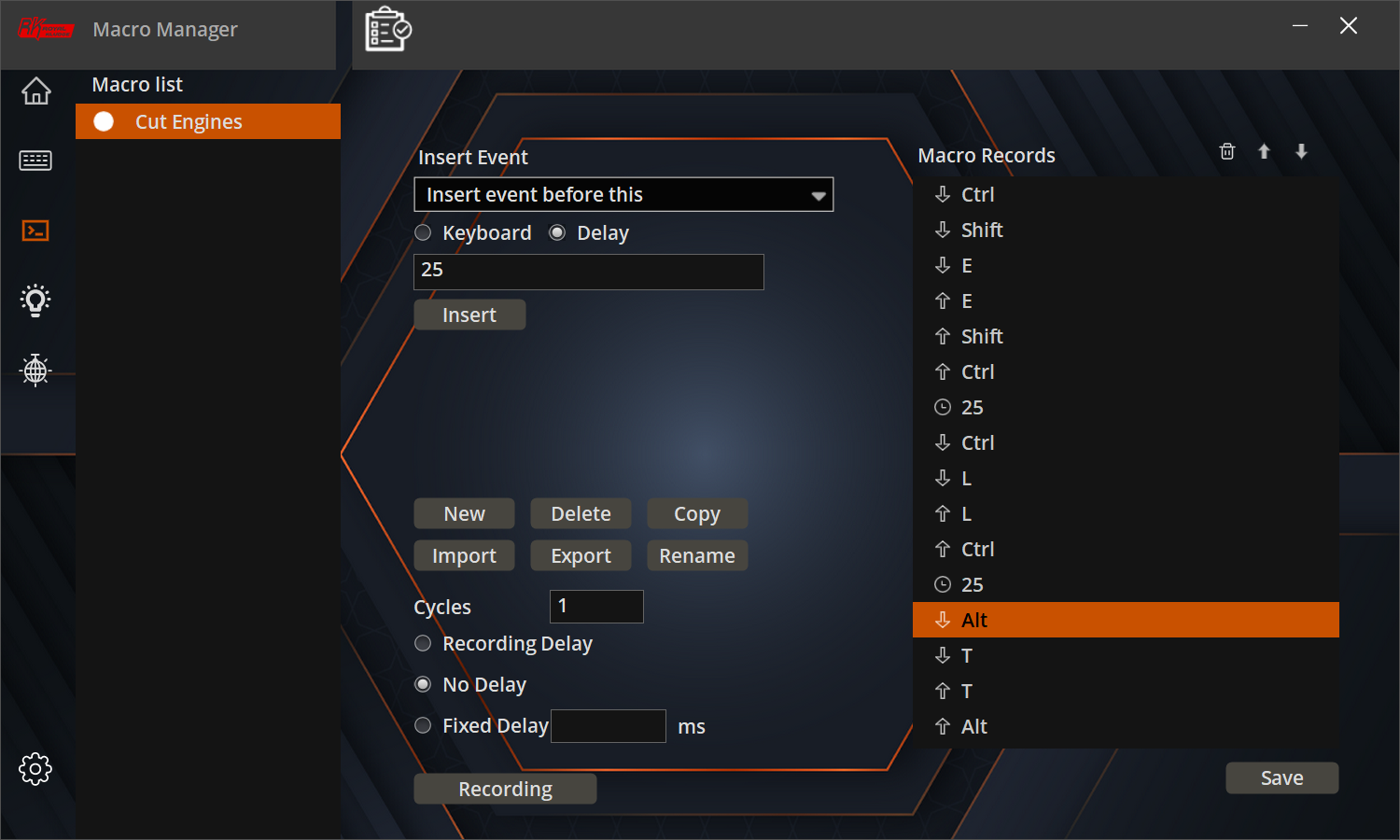
The RK Keyboard programming app downloadable from Royal Kludge’s website isn’t going to win any design or usability awards, and the lack of documentation or built-in help for it doesn’t help matters. That said, once you figure out the user interface, it’s reasonably powerful, allowing you to not only reprogram all of your key assignments, but also record elaborate macros complete with customizable delays between key press and raise actions.
The software also lets you choose between about 30 lighting and effects modes, and program your own as well. You can also create custom backlight sets using Fn key sequences on the keyboard without using the software at all.
You’ll likely want to keep the software installed, though, because the keyboard stores only a single custom profile, and you’ll need to use the software if you want to swap lighting or key assignments.
Bottom Line
Given the subpar experience we had with the earlier RK84, I was pleasantly surprised at how much I enjoyed using the RK96. The wireless quirks are fixed, the addition of the sound-deadening foam gives a pleasant audio signature, and the compromises in layout made to shrink the design didn’t cause any hassles with touch-typing, unlike its RK89 counterpart. The multiple connectivity options are really convenient, and the trio of Bluetooth profiles and PC/Mac switch on made it easy to swap the keyboard between my gaming PC, my work MacBook, and my iPad Pro.
The easy customizability will make this attractive to keyboard modders as well. Whether you just want to swap in high-quality switches for the WASD keys to up your game or completely swap out the switches and keycaps, it’s quick and painless to make the change.
Its closest competitor is probably the Akko 3098B / N, which offers equally flexible connectivity and swap-ability and a similar compact layout, as well as full RGB color, but has a much smaller battery, lacks the volume roller, and costs $30 more.
Overall, this is a lot more keyboard than you’d expect for the price, and is a fantastic choice as a foundation for creating your own custom setup, particularly if size matters but you don’t want to sacrifice the convenience of a numeric pad.
-
bolweval Looks like the first keyboard i ever had back in the early 90's minus the LED's. It's gonna show dirt like the old ones too..Reply
